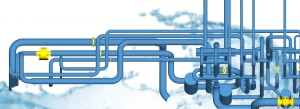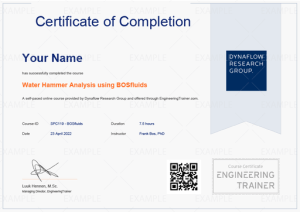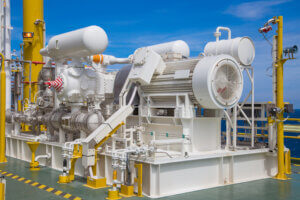
Water Hammer Analysis using BOSfluids
Training Courses Water Hammer Analysis using BOSfluids: Surge Analysis Download Brochure About The Course This course teaches you all the fundamentals of performing water hammer
Pulsation studies can result in quite elaborate and complex reports with large output data sets. To the non-specialist, it may feel like you are being confronted with difficult recommendations to which you should adhere, yet it is unclear how these were concluded based on the large “black box of data” that is submitted by a pulsation specialist. You may therefore think that you need to be a subject matter expert to review pulsation reports. Whilst this is partly true, there are significant parts of these studies that you can review for yourself, even if you are not an expert.
In this course, it is shown which steps a non-specialist can undertake in reviewing a pulsation analysis. It is shown which topics should be present in a pulsation report and how they relate to the conclusions and recommendations. How to evaluate the robustness of the results in the pulsation study is explained, and to illustrate how to validate these, the BOSview software suite is used. The topics in this course include how to review the chapters in the pulsation analysis report about pumps and compressors, dampers, piping geometry, pulsation levels and mechanical vibrations.
Important note: This course does not cover pulsations and vibrations fundamentals or details of how to conduct the different design analyses per API618/API674.
This course contains 4 online modules based on video content and demonstrations in BOSview. An example model is explained for each subject that is discussed.
You receive 1-year unlimited access to the course. This allows you to perform modules again, should you need to refresh your knowledge for your work projects.
Course evaluation survey
Your Personal Certificate
Rate this course
Related resources
Follow up
Self-Paced
This course is self-paced and is not subject to specific dates. The course contains 4 modules with a total of 1.75 hours of content which can be performed at your own pace. A personal certificate will be provided to you if you finish the course within the first month after purchase. This incentive aims to motivate you to perform the course on time, thereby improving your learning curve.
Classroom
This course is scheduled for one work day. The dates of the course are organized upon inquiry.
This course is available in self-paced, hybrid, and classroom formats.
Prerequisites and level
Intended For
This course is designed for:
Pulsation and vibration engineers who want to know how BOSview can be used as supplementation to standard documentation.
Non-specialists who have received pulsation and vibration study results from a third party.
Project managers involved with the acquisition of pumps and compressors.
Access to the self-paced course
After your purchase is confirmed you receive an account to the EngineeringTrainer online learning portal, where you can find the course in your dashboard. After opening the course you will be guided step-by-step through the different modules. You receive 1-year unlimited access to the course, allowing for the repetition of modules as desired.
Course Videos
The course is mainly based on video content: video lectures and video software demonstrations. Videos can be viewed as many times as desired. The video lectures help you to grasp the important technical concepts and in the video demonstrations the instructor uses the software and discusses all the steps and actions. You are recommended to follow the steps of the instructor in the software to optimize your learning curve.
Participants of the self-paced course receive a personal digital certificate if they meet the following requirements:
Participants of the classroom course receive a personal physical certificate upon the completion of the course.
Example certificate:

After this course, participants are expected to:
Can perform a concise review of a pulsation study to verify that the study meets the minimum quality levels.
Understand the important aspects of a pulsation report.
Know how to utilize BOSview to review pulsation study results.
Can identify potential issues that should be reviewed by an expert.
Can ensure that the documentation of a pulsation analysis is complete, enabling an in-depth review when required.
Video lectures
Video demonstrations
The majority of training material are videos. These are not available for download, but can be accessed directly with your account on the portal. Apart from quizzes the exercise files can be downloaded. These can include .pdf files with the exercise questions, software models or other file types. You receive 1-year unlimited access to the course. This allows you to watch content again if this is beneficial for your work projects.
No, it is not possible to ask questions to the instructor. It is possible to submit comments and ideas for new topics and modules.
Participants receive 1-year unlimited access to the course including new videos that are added during this year. Participants receive an email notification upon addition of new course videos.
No software is required for participants of this course.
If your computer and internet connection is able to play videos online (YouTube) you will be able to follow the course. Note that almost all browsers are supported, except for Internet Explorer.
Yes, this course qualifies for PDH hours as per the NCEES CPC Guidelines.

Training Courses Water Hammer Analysis using BOSfluids: Surge Analysis Download Brochure About The Course This course teaches you all the fundamentals of performing water hammer

Training Courses Pulsations And Vibrations: Reciprocating Compressors Free Course Preview Download Brochure About The Course This course imparts fundamental knowledge of pressure pulsations in piping,

Training Courses How to Review a Pulsation Study About The Course Pulsation studies can result in quite elaborate and complex reports with large output data
Laan van Oversteen 20
6th floor
2289 CX Rijswijk
The Netherlands
© Dynaflow Research Group BV